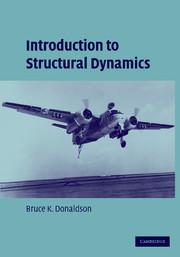Book contents
- Frontmatter
- Contents
- Preface for the Student
- Preface for the Instructor
- Acknowledgments
- List of Symbols
- 1 The Lagrange Equations of Motion
- 2 Mechanical Vibrations: Practice Using the Lagrange Equations
- 3 Review of the Basics of the Finite Element Method for Simple Elements
- 4 FEM Equations of Motion for Elastic Systems
- 5 Damped Structural Systems
- 6 Natural Frequencies and Mode Shapes
- 7 The Modal Transformation
- 8 Continuous Dynamic Models
- 9 Numerical Integration of the Equations of Motion
- Appendix I Answers to Exercises
- Appendix II Fourier Transform Pairs
- Index
- References
3 - Review of the Basics of the Finite Element Method for Simple Elements
Published online by Cambridge University Press: 30 November 2009
- Frontmatter
- Contents
- Preface for the Student
- Preface for the Instructor
- Acknowledgments
- List of Symbols
- 1 The Lagrange Equations of Motion
- 2 Mechanical Vibrations: Practice Using the Lagrange Equations
- 3 Review of the Basics of the Finite Element Method for Simple Elements
- 4 FEM Equations of Motion for Elastic Systems
- 5 Damped Structural Systems
- 6 Natural Frequencies and Mode Shapes
- 7 The Modal Transformation
- 8 Continuous Dynamic Models
- 9 Numerical Integration of the Equations of Motion
- Appendix I Answers to Exercises
- Appendix II Fourier Transform Pairs
- Index
- References
Summary
Introduction
The first two chapters provided the basics of small-rotation dynamics with applications to rigid bodies or near rigid bodies. The purpose of this chapter is to provide an introduction to the finite element method (FEM) of structural analysis to the limited extent necessary for the use of this textbook. That is, the present discussion of the FEM is limited mostly to one-dimensional structural elements.Specifically, all the example problems and exercises deal only with linear, beam finite elements and linear,spring finite elements. Neither of these elements require the finite series sophistication of two- orthree-dimensional elements such as plate or solid finite elements. A very brief introduction to multidimensional finite elements is presented in Endnote (). If the reader is already familiar with the FEM, then this chapter can be skipped, particularly because the next chapter provides ample further review of this topic. Since the finite element method is so extensively used for, and so particularly suited to, structural dynamics analyses, no other method of structural analysis is used for the calculations presented in this textbook. For the sake of instruction, the use of the FEM in this textbook is oriented to hand calculations rather than the use of one of the many available and routinely used commercial software programs that all do essentially the same things and differ only in style. Thus the reader should be able to gain insight into what all such FEM programs need to do.
- Type
- Chapter
- Information
- Introduction to Structural Dynamics , pp. 99 - 156Publisher: Cambridge University PressPrint publication year: 2006



